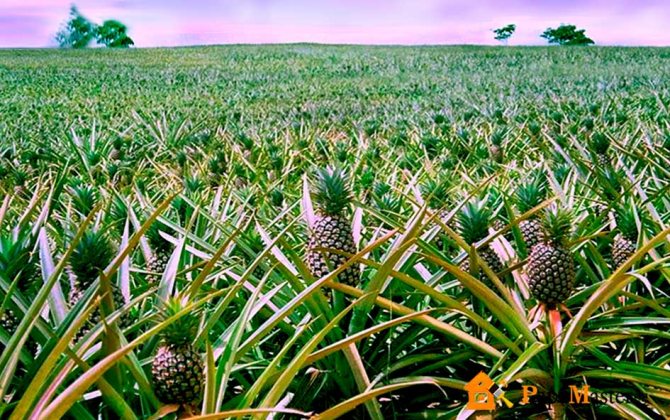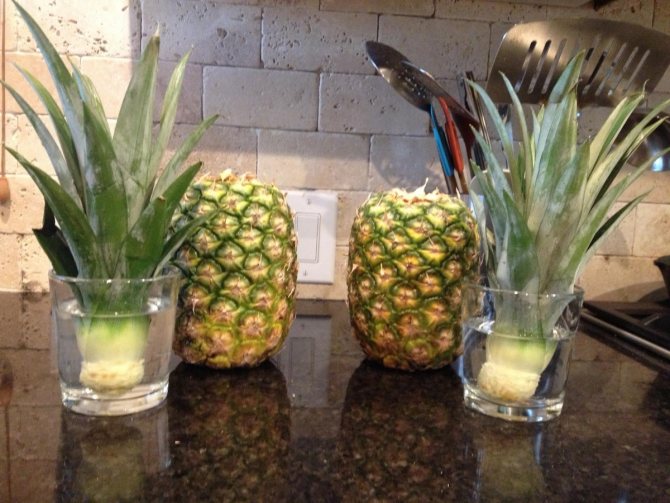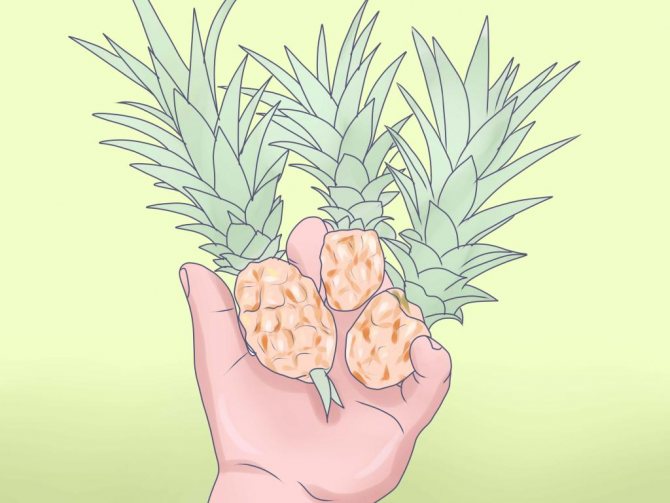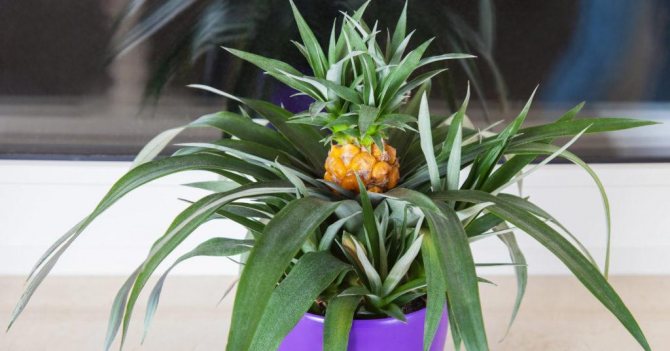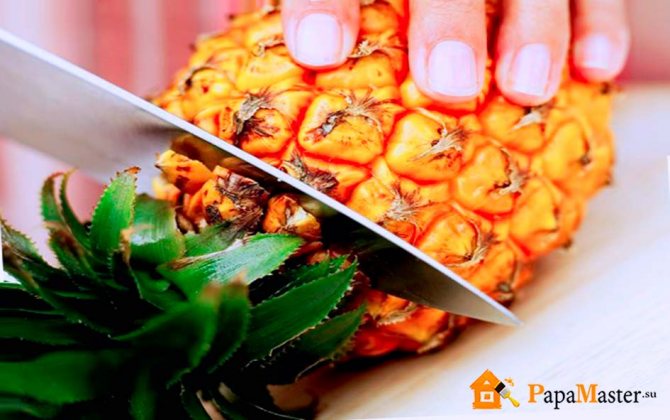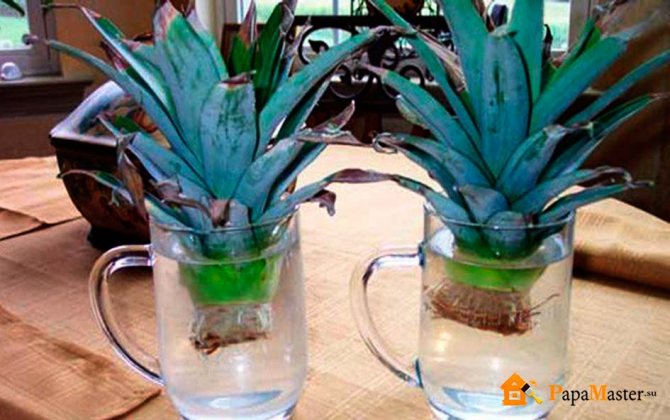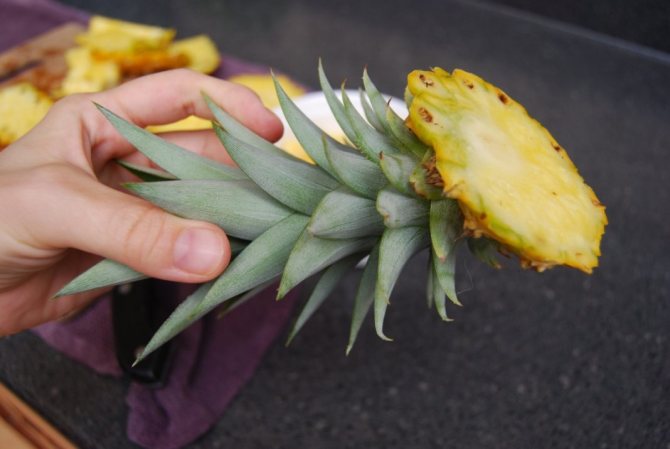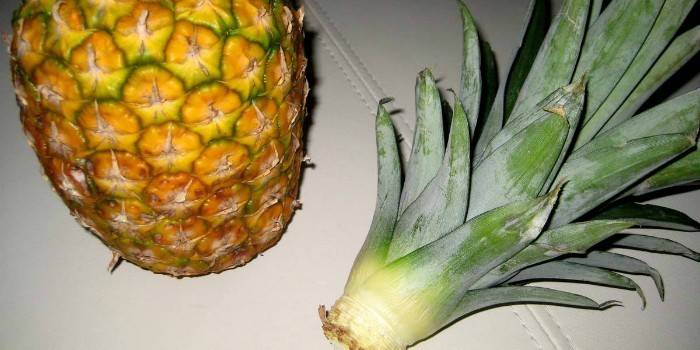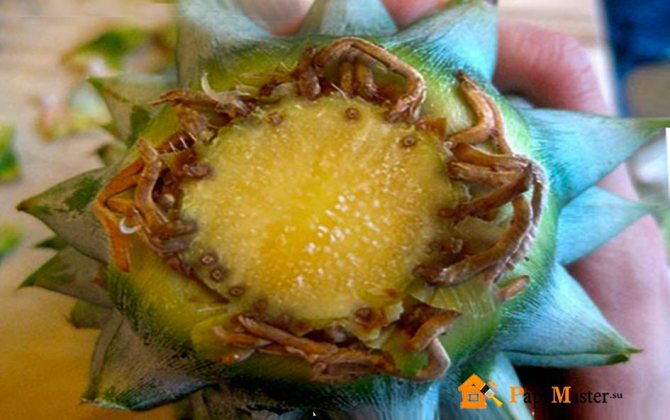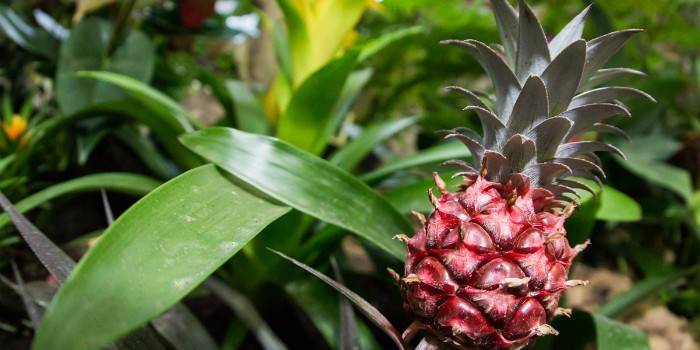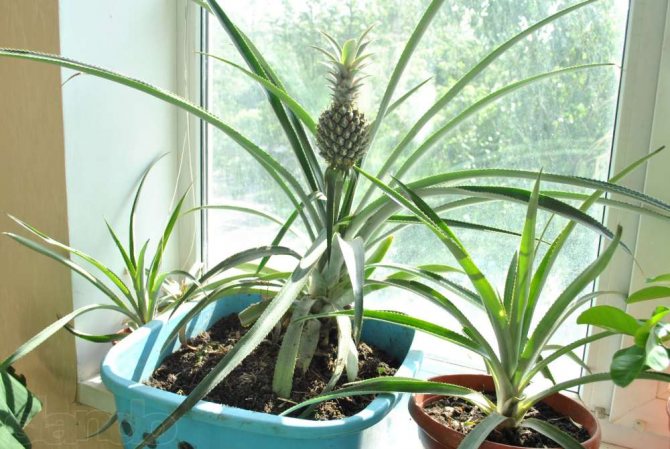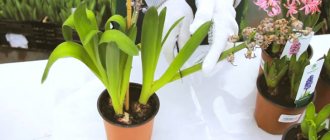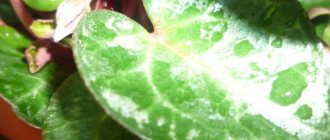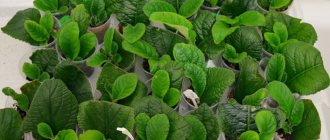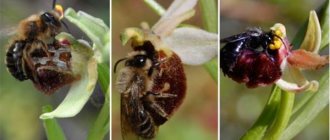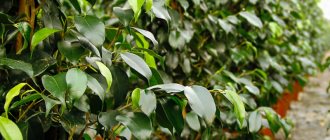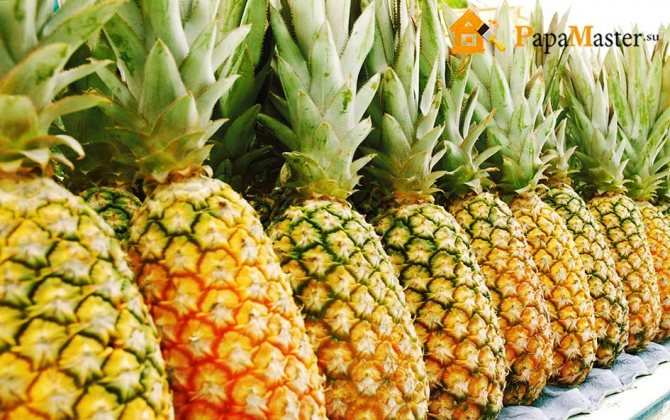
A wonderful exotic fruit, pineapple is adored by adults and children. A perennial plant with a massive stem, native to Brazil, but also grows in Colombia, Australia, Paraguay, Venezuela, North Africa, Hawaii and is distinguished by the presence of different varieties. It is grown in the subtropics, but when certain conditions are created, it will grow and bear fruit in a greenhouse or apartment in our climate. What methods of cultivation exist, what stages are important, how to avoid a mistake, about this in detail in our article.
It is interesting:
There is still controversy over what pineapple is. There is an interpretation that it is a berry, vegetable, fruit, cereal.
Will it be possible to grow?
Pineapple is a herbaceous perennial plant that belongs to the bromeliad family. It grows in the equatorial and tropical parts. It is grown in the Philippines, Thailand, USA, Latin American countries. There are 9 types of culture. The most common is considered to be large-crested.
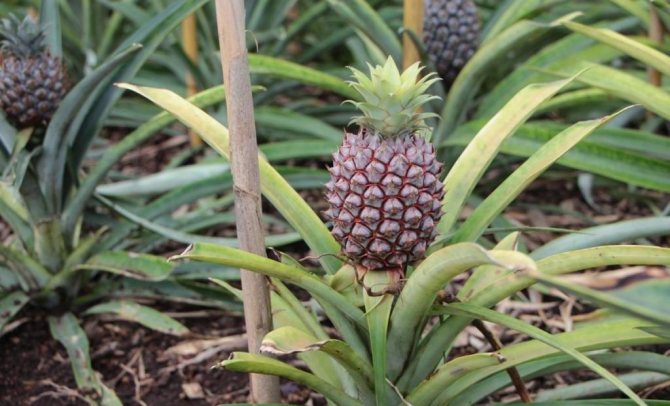

Many people are interested in how pineapple grows in nature? The plant is presented in the form of a small bush with long leaves. The fruits are at the top, as if someone had placed them there. How does pineapple grow in nature if it is grown for sale? These are whole fields, completely covered with fruits.
How does pineapple grow at home? It turns out a wonderful plant, the main thing is that there are greenhouse conditions. This does not require a special room, an apartment is suitable. Fruits grown in this way are only slightly smaller than fruits that are brought to shops from other countries. But the taste and aroma are the same. The main thing is to know how to grow pineapple.
It is important to know that
- A few days before planting "Crown", you can disinfect the soil by frequent watering with boiling water.
- In winter, plant growth stops, but resumes in spring. If this does not happen, the soil should be changed.
- The dried tips of the leaves must be cut off.
- It is useful to read the literature on plant diseases and parasites. For example, washing the plant in a soapy substance and then with clean water will help get rid of worms and mites.
Thus, having an exotic plant at home and surprising guests is quite real! Each planting method has a positive result. It remains to decide which one to use for you.
Fruit selection
How to grow pineapple from the top of the house? It is important to choose the right fruit. To eliminate errors, you need to take into account the following recommendations:
- You should pay attention to the leaves. If the pineapple is of good quality, it is green and firm. Do not buy fruit with yellow or brown leaves.
- It is important that the color of the peel is golden yellow.
- A healthy fruit should have moderate firmness. Don't choose tough pineapple. And if it is very loose, then this is considered a sign of poor quality.
- It is better to buy pineapple in late August or early September. If you buy a fruit in winter, you need to make sure that it is not frozen. A healthy plant will not be grown from it.
- It is important that there are no gray spots on the peel.
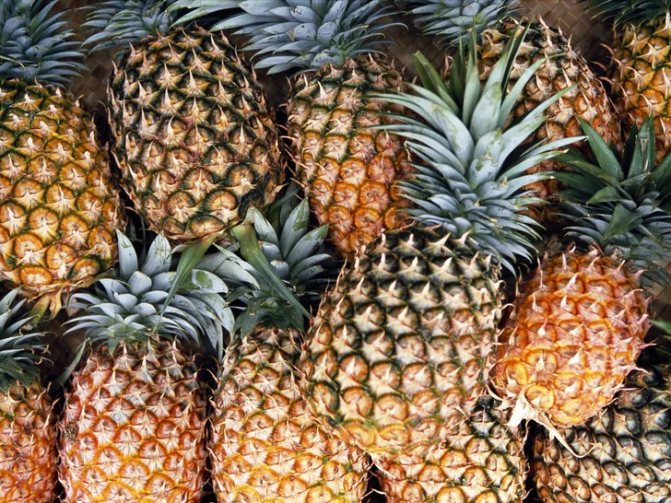

Only when choosing a high-quality fruit, growing pineapple at home from a tuft will be successful. But you will also need proper care.
Basics of growing principles
Why is pineapple so relevant and used in many salads and desserts? The point is its incredible taste and useful qualities, moreover, the original appearance is suitable for decorating a festive table. When eating pineapple, you need to carefully separate the green crown, however, this is not necessary at all. You can use it to grow pineapple not only in a greenhouse, but also in an apartment.
Unlike many plants, pineapple is incredibly moody and requires a lot of attention, if you do not have experience in growing, for example, lemons, you will have to try hard.
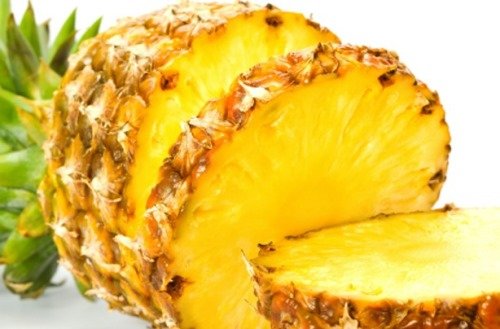

If you love experimentation and difficulty, then growing pineapple you will love it. To begin with, you will have to make a lot of mistakes, however, after reading the article, you can avoid unforeseen circumstances.
For the first time, you need to try to grow a plant from the upper part, in other words - a crown, remove it from the seed. When buying pineapple in the market or in the store, take a look at the state of the crown. If it has already been frozen once, then it will not be suitable for growing. For example, in the winter season, absolutely all pineapples are cold-treated, besides, they were taken to the store in an ordinary truck, where there is no heating. Buy pineapple in autumn or summer, and take a look at the quality of the crown, the center should not be damaged, and the leaves on the inside should be green and juicy.
Priming. Important nuances of choice
What soil is needed for pineapple? A mixture of coarse river sand, peat and leafy or sod land is required. Some sand is replaced with perlite. There are several soil formulations for pineapple:
- Peat and river sand are mixed in the same amount.
- Sod and leaf land, peat, birch sawdust, coarse sand in a ratio of 3: 2: 2: 2: 1 are combined.
- Leaf humus is mixed with turf, sand and peat (2: 1: 1: 1).
Ready mix for bromeliad plants is also suitable. You should not choose land that is intended for other plants. 2 days before planting the fruit, the substrate must be poured with boiling water for disinfection and moistening.
Planting pineapple in the ground
The soil for growing pineapple should be loose, moist and rich in nutrients. For rooting, not a clean substrate is best suited, but a mixture of universal soil, river sand and peat. At first, you will need a very tiny pot with a diameter slightly larger than the stump itself. Place expanded clay or vermiculite on the bottom to allow drainage. Despite the fact that pineapples love moist soil, they quickly die when the water is stagnant. Place the pot on the south side, but protect it from direct sunlight.


It will take about 6-8 weeks for rooting, and when new leaves begin to hatch, then everything went well - the pineapple took root and started up real roots. If the plant does not show any signs of life for 2 months, most likely it has died. Over time, old leaves will dry out and die off, and fresh leaves will come in their place. To speed up development, as the old foliage dries up, prune it carefully. Watering should be carried out no more than 1 time in 5-7 days.
When about a year has passed at this rate, the pineapple should be transplanted into a larger “apartment”. You will also need to add a soil mixture, and it is better to choose a soil specifically for succulents. Don't forget about good drainage.
Helpful advice: If in winter the pineapple slows down development or stops changing altogether, then it “fell asleep”, as nature intended for all plants. But if he is not active in the spring, he may have depleted the potting mix and needs additional nutrition. Repot the plant by adding new soil.
Homemade pineapple care
As we already said, growing pineapple is not so difficult, but you need to try to create optimal conditions for it. The first thing to learn is that the cold will kill this thermophilic tropical plant, and the colder it is in the apartment, the slower it will develop. In the summer, you can safely take it out to the balcony, but with the first cool notes in the air, it is better to rearrange the pot inside the house. If you have a garden, feel free to place the pineapple in the sunniest place - being outdoors and in a spacious atmosphere strongly stimulates growth.
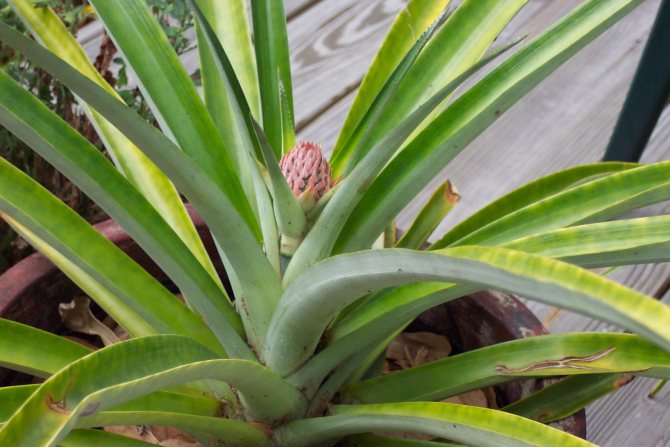

Pineapple needs at least 6 hours a day to be in a lit place, whatever the weather outside the window. In winter, sunlight can be very tight, so we recommend that you take care of artificial lighting in advance. Purchase fluorescent lamps (cold and warm spectrum) so that the plant does not suffer from nutritional deficiencies on cloudy days. This will benefit not only pineapple, but also other indoor plants, so for the winter you can arrange a kind of flower garden with an artificial "sun" in one of the corners of the room.
Despite its thermophilicity, pineapple must be kept away from heating appliances, otherwise it will dry out. Drafts can also damage the plant. It should be watered once a week, and not only pour water on the ground, but also spray the leaves so that the water flows down them to the center (pillar) and additionally nourishes the pineapple.
Helpful Hint: If you overdo it and the water stagnates, the characteristic rotting smell will appear and the plant will begin to "ache". In this case, you should not wait until the excess water evaporates, but replace the soil immediately, otherwise the pineapple may die.
Diseases and pests
If a plant lives in an apartment, this does not mean at all that it is insured against diseases and pests, although the impact is minimal. Indoor pineapples did not pass this fate either. As for pests, the main problems are all sorts of mites and mealybugs. It is quite simple to remove them - you just need to rinse the plant with a mild soapy solution, then wipe it with a sponge dipped in clean water. You cannot leave a soapy film on the leaves - they will not be able to eat. You can also use insecticides, but it should be remembered that these are highly toxic poisonous substances that will certainly kill all pests, but also cause some harm to the plant itself and even affect its fruits.
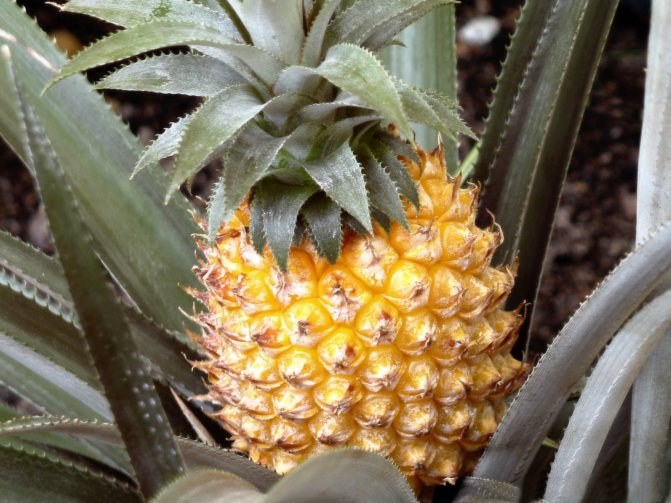

Another danger that can lie in wait for indoor pineapples is core rot. It is provoked by a fungus, and as a result of its activity, the leaves of the plant turn black and fall off. If the plant is infected with a fungus, only a fungicide can save it - it must be poured into the core. But even in this case, there is no 100% guarantee of cure. If the fungicide helps, then the pineapple will have new shoots, and the old trunk will need to be cut off.
Fruiting pineapple
If pineapple grows in its natural environment, it takes about 26 months for it to start bearing fruit. In the case of homemade pineapples, it is very difficult to predict the development of events - everything is purely individual and depends on the growing conditions. Usually after 15-17 months, when the plant reaches a height of 25-30 cm, the first inflorescences appear. A large bud appears at the very top, the stalk grows, moving the bud up, and after 1.5-2 months flowering begins. It lasts about 2 weeks, and this spectacle serves as a real reward for all the care of the plant - beautiful bright blue or purple flowers bloom one after another, forming rows.
Each flower lives only a day, and when the last flower fades, the fruit begins to develop. The formation of a full-fledged pineapple can take from 3 to 6 months. Depending on the type of plant and growing conditions. However, more often than not, homemade pineapples refuse to bear fruit - this is the main difficulty. Sometimes they do not even bloom or bloom, but they are so weak that the fruit set does not occur at all.
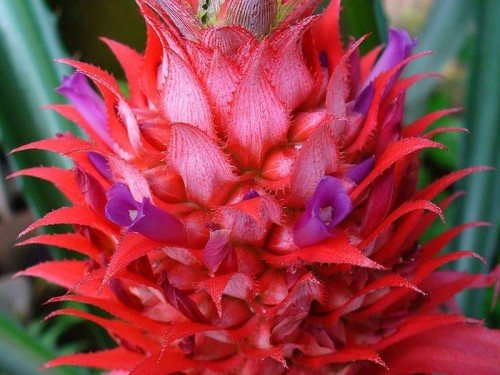

This problem is solved by special procedures - the stimulation of fruiting. For indoor plants, stimulation should be carried out only if the length of the pineapple leaves is 60-70 cm, and the thickness of the trunk is 6-10 cm. This means that the plant is fully formed.
Important: It is possible to stimulate the fruiting of pineapples only in the warm season, when there is enough light and heat for the development of the bud and fruit.
Recipes for stimulating the fruiting of homemade pineapples:
- Dip a 10-15 g piece of carbide in a liter jar of water, wait until the reaction ends (the water will boil due to the release of acetylene gas) and measure out 2039 ml of the remaining solution with sediment. Pour it into the funnel of leaves, in the center of which is the growing point. Repeat the procedure the next day (you do not need to prepare a new solution, but use the existing one).
- Cover the pineapple with plastic wrap or a large bag, put a half-liter jar of water in an impromptu greenhouse and dip a 5 g piece of carbide there. Acetylene will start to evolve, and the bag should not allow gas to pass through. Perform this operation with the "gas chamber" for three days in a row, after which you expect the bud to develop.
It is worth noting that fumigating a plant with acetylene smoke is less effective than pouring a carbide solution into the growing point. If you followed the first recipe, flowering should start in 4-6 weeks. If the pineapple does not want to please you with blue flowers, then one of two things: either it is sick, or it is not yet ready to bloom, and we must wait until next year.
And now, on the one hand, sad news - after fruiting, the pineapple dies. However, only the central most developed part of the plant dies off, which is crowned by the fruit. Before this, lateral shoots appear, and they can be used for breeding the next generations of pineapple, as well as the stump from the eaten fruit.
Top preparation
How to plant the crown of a pineapple? The preparation is done like this:
- The top must be grasped with your hand and carefully turned out. It is important that the inner stem separates with the leaves.
- If the pineapple is unripe, difficulties arise during this procedure. Then you need to use a knife with which the leaves and root are extracted. When cutting, you need to observe an angle of 45 angle. Do not place the knife horizontally.
- The pulp on the stem must be removed, otherwise the planting material will rot. From this place, the pineapple root system develops.
- From the tuft, you need to retreat 3 cm and cut off the top with leaves. The result is a shank with a crown. The lower leaves are also cut off. The main thing is that the kidneys are not damaged.
- Then you need to perform preliminary germination. Settled water at room temperature is poured into a glass and the stalk is lowered there. It is important that it is submerged 3-4 cm.
- The glass must be placed in a warm, lighted place. The water should be changed after 2-3 days.
- After 3 weeks, roots are formed at the top, and then it is transplanted into the ground.
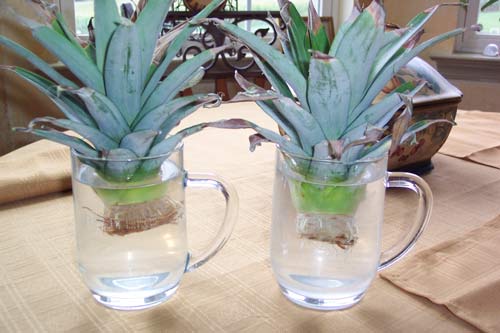

There is also an alternative processing option. The handle should be hung on a rope in an upright position with the crown down. The plant dries up within 2-3 weeks. After this procedure, the tip takes root well. The stalk is treated with a weak solution of potassium permanganate to prevent rotting.
How to sprout pineapple?
The first step is to choose the right tropical fruit. Only healthy tops are suitable for germination. When buying, you should pay attention to the base. There should be no gray or yellow spots on it. A good rosette is dense, green, rich in color.
Further course of action:
- Take the fruit in your left hand and grasp the greens tightly at the base with your right.
- Scroll the top. If it doesn't come off, cut it off with a sharp knife.
- Peel the bottom of the crown about 1.5-2 cm, breaking off the leaves one at a time.
Then the pineapple can be germinated in water or planted immediately in a pot with a substrate. Some additionally dry the top for 2-4 days. To do this, it is suspended from a rope in a well-ventilated area (for example, on a balcony). When drying, the cut sites are tightened with a fabric stopper, which prevents the penetration of bacteria and plant decay.
One crown can grow 2, 3 and even 4 pineapples. To do this, cut it lengthwise with a sharp knife and dry it thoroughly. The split top is germinated in separate containers. The cut points should not come into contact with anything, otherwise the edges will begin to rot and the plant will disappear.
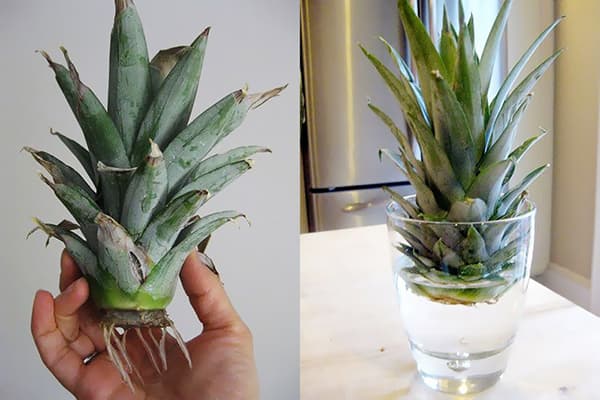

Germination in water
Pineapple germinates in water in 10–21 days. Roots appear at the point where the apex is attached to the fruit. Usually, many roots grow at once and at the end of the third week they are over 2 cm long.
When germinating, it is important to follow a number of rules:
- Use transparent glassware. For some reason, pineapple does not like plastic containers.
- Make sure that only the bare base is in the water and the leaves remain dry.
- It is impossible for the base of the crown to touch the bottom - this way the roots will not develop.
- Change the water regularly - once every 3 days, and preferably daily.
- Defend the water for at least 24 hours.
- Pineapple will germinate at a temperature of at least 22 degrees. Find a warm place for him.
Pineapples grow best in small fruit and vegetable puree jars filled with water. No need to pour it to the brim. It will be correct to leave 2-3 cm to the neck. The tip is pushed from above.
To maintain the optimum temperature, place the sprouting pineapple on the plank on top of the battery. Or use the heat of the computer system unit (but in no case cover the ventilation holes with the jar).
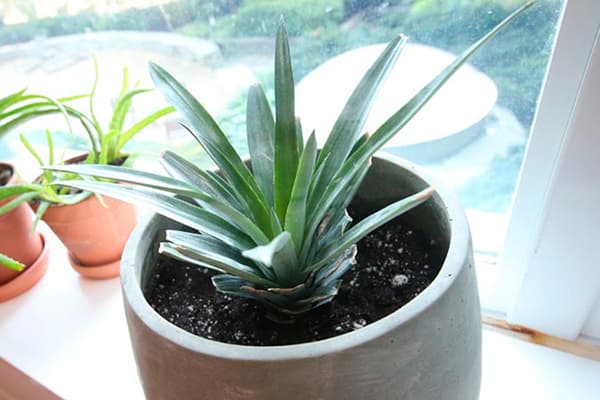

Landing
How to grow pineapple in a pot? The procedure is performed according to the following instructions:
- Prepare the pot. It is important that it is not inferior in size to the pineapple cut at the tuft. Since the plant is transplanted during growth, you can choose a container with a diameter of 30-35 cm. But if this is not possible at this stage, you can choose a container with a size of 15 cm. A drainage hole is required to prevent moisture stagnation. It is better to plant pineapple in a container with small sides, but with a large diameter. This is due to the root system, which is located in the top layer of the soil.
- A layer of expanded clay 2-3 cm is poured at the bottom of the pot.
- The pot is filled with soil.
- In the middle of the container, create a dimple 3 cm deep, place the top with the roots and cover with soil until the leaves.
- Use your fingers to compact the soil.
- The plant needs to be watered a little. It is important that the soil is slightly damp.
- The container is placed in a warm place that is well lit. If the planting was carried out in cold weather, the seedling is covered with plastic wrap, which provides the desired microclimate.
- How to root the top of a pineapple? In addition to observing the above rules, you need to observe some nuances. The room temperature should be 25-27 degrees. This procedure takes 1.5-2 months. Do not leave pineapple in direct sunlight.
- When the first sheets appear, the film must be removed.
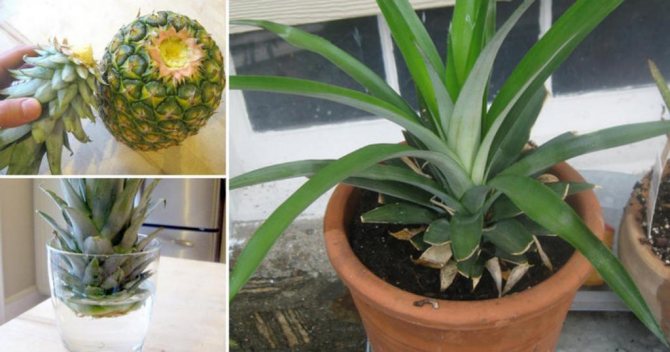

These are all tips on how to grow pineapple. In addition, proper care must be observed. All the nuances of proper cultivation, ensuring the normal development of the plant, are presented below.
Where to begin?
To begin with, get rid of the green pineapple rosette, cut it neatly directly near the base of the stem. Make sure that there is no pulp left on it, and then wash it in a weak solution of potassium permanganate. Next, sprinkle the outlet with crushed coal or ash, if you don't know where to get them, buy activated carbon at the pharmacy. Then leave the cut for six hours to dry completely.
When dry, plant in a pot, the minimum pot capacity is 0.5 liters.Pour drainage into the bottom of the pot in advance, then add a little loose soil mixture of leaf humus, turf, peat and sand. On top, add a 3 cm layer of a mixture of leaf humus together with sand in a 50/50 ratio. But you can skip the time and just purchase the bromeliad mix from the hardware store.


After that, in the central part of the pot, make a two centimeters depression, the diameter should be the same as that of the outlet or slightly larger. Add a little charcoal to the hole to keep the tip from rotting over time. Then slowly lower the outlet and lightly press down on the ground. Stick 3 sticks from each edge of the pot, then fasten the rosette to the threads.
Water the soil and place a plastic bag over the pot, preferably a transparent one, and store it in a well-lit area. For rooting to take place, the room must be at a temperature of 25 degrees Celsius. If you nevertheless decide to grow pineapple in winter, then it is better to place the pot near a radiator or other place that warms up well. Do not place the pot on a radiator without bedding, but instead use a piece of styrofoam to avoid over-temperature. Further, the gradual growth of pineapple will begin, after two months the roots will appear, and a little later new leaves will grow. Do not remove the bag earlier than 2 months after rooting. If the pineapple is adult, then after a while lateral layers will appear near the stem. You can root them in the same way as an outlet, at this stage you can already create your own plantation for growing plants in large quantities.
Pineapples are transplanted every year, however, you should not get carried away with this either, because the roots need a place to grow, and you need to increase the capacity of the pot when transplanting. The neck of the root is pushed inside by no more than 5 millimeters. The deformations of the earthen coma must not be allowed, otherwise the root system can be disturbed. It is quite fragile and small, so you will need a pot with a capacity of 4 liters to grow an adult plant.


Temperature
In order for the plant to develop correctly, it is necessary to follow a few simple recommendations:
- The room where the pineapple grows should have a temperature of 22-25 degrees.
- In winter, it should stay within 16-18 degrees.
- If the temperature does not correspond to the desired indicators and the room is very cool, you need to turn on the heating devices.
- If the plant is located on a windowsill, it is protected from drafts and frostbite.
- In the cold, it is advisable to rearrange the culture in the warm part of the apartment.
The right temperature will ensure beautiful flowering and fruiting. It greatly affects the general condition of the plant.
What conditions are required for growth?
You need to pay attention to the flow of natural light and heat, these are the most important components of the rapid growth of pineapple. It does not require high humidity and grows quickly even in an apartment where the air humidity is quite low. Pineapple has a high immunity against microbes, and also does not need regular watering. If you put it on a windowsill near a window, where sunlight constantly gets in, the pineapple will grow in a couple of years and turn into a huge bush with incredibly beautiful dark green leaves.
During cultivation in the summer season, you need to maintain a temperature of 30 degrees, at least 25 degrees. In summer, pineapple can be taken outside, however, by the evening or at night, the temperature can drop to 15 degrees, so you need to bring it home at night. In the winter season, a temperature of 22-25 degrees is quite enough, but if the temperature drops to 18 degrees, the decomposition of the plant will begin and it will certainly die after a while.
Hypothermia of the pineapple roots must not be allowed, so do not put it on a cold windowsill, especially in the winter season.Buy a fluorescent lamp for the winter to illuminate the plant. Remember that the pineapple must receive light within 12 hours.
Water the pineapple with exceptionally warm water at a temperature of 30 degrees, you can add a little lemon juice. When watering, you need to add water directly to the outlet, but remember not to water the pineapple too often, as the roots will rot. Wait until the soil is completely dry before watering the plant again. It also needs to be periodically sprayed with water and lemon juice, this promotes rapid growth.


You need to fertilize the plant with special mineral complexes with a liquid consistency. They do this every two weeks, in no case more often. Once a month, you need to water and spray the pineapple with clean water with the addition of ferrous sulfate. Concentration - gram of vitriol per liter of water. Do not use alkaline fertilizers such as lime or wood ash, this will kill the plant.
What to do to make the pineapple bloom? If you follow the instructions and do everything right, the pineapple will bear fruit after three years. After 3-4 years, the leaves grow and acquire a length of 80 centimeters. But the problem is that an adult pineapple is very reluctant to bloom. To stimulate flowering, fumigation is used, a polyethylene bag is put on the pineapple (not too dense). Next, two or three cigarettes or smoking coal are placed near the pot for ten minutes, but do not forget about the risk of fire, everything must be under control. Repeat the procedure three times, you can do it once a week. After a couple of months, you will see that flowering begins to appear from the outlet directly in the center. In four months, the fruit will appear with a weight of ripe fruits from 300 grams to 1 kilogram.
Watering
Pineapple should not be watered heavily. In nature, it lives in tropical climates where the plant does not receive water for several months. Watering should be done 2 times a week. In winter, this should be done once every 7 days.
The condition of the soil and the plant must be taken into account. If the soil is dry or the leaves begin to fade, this is a sign that the pineapple needs moisture. Watering should be done in an outlet that is filled to 2/3 of the volume.
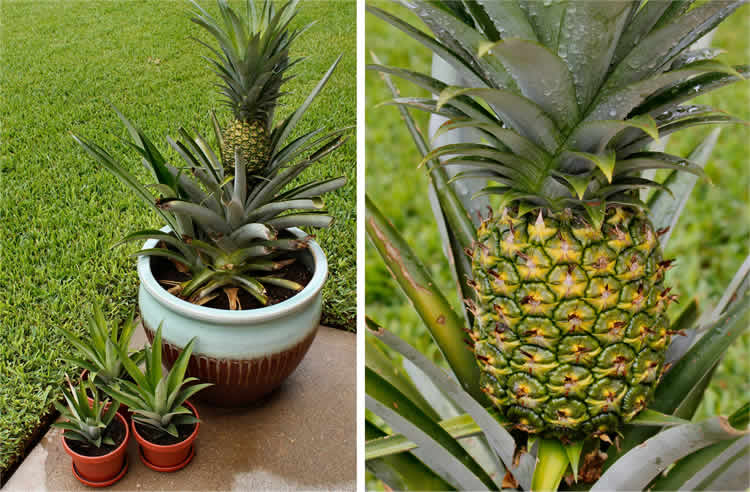

You only need settled or filtered water at room temperature. It is allowed to add lemon juice (a few drops) to the liquid. A large amount of moisture leads to rotting of the plant.
How to use pineapple seeds correctly
The use of seeds in pineapple propagation is accepted, but it is a rather laborious and complex process. This is explained by the fact that only purchased seeds will be suitable for obtaining seedlings. They are characterized by the presence of a brown or reddish-brown color, they are distinguished by a semicircular shape with a length of 3-4 mm. A day before planting, it is recommended to place the seeds on wet wipes in a warm place. After a slight swelling, they should be planted in a well-moistened peat-sandy soil. To simplify the germination of seeds, it is recommended not to plant them deeper than a couple of centimeters.


After planting, the pot must be covered with foil and placed in a warm place. Temperature plays a key role in ensuring high germination of seeds, as well as speeding up this process. If the temperature is at room temperature, then the appearance of the first shoots will have to be expected no earlier than 3-4 weeks, and sometimes it can take up to 6 weeks. But ensuring the ambient temperature at the level of 30 -32 degrees will reduce this term to 2-3 weeks.
However, maintaining the correct temperature regime is not a basic requirement, the soil needs timely moistening, in addition, seedlings will not interfere with feeding. Therefore, it is recommended to use complex formulations with microelements for fertilization once every couple of weeks.
The appearance of several leaves on the outlet signals the need for a dive, while it is necessary to use special soil. To form it, you need to use equal parts of peat, sand, garden soil and humus. At the same time, about 5% of the volume should be allocated for charcoal, which will help to ensure the availability of protection against soil infections. In addition, you can use perlite instead of sand.
Lighting
Pineapple is a light-loving crop. But direct ultraviolet rays are undesirable for him. It is best to place the plant on the east or west side. Do not put it on the south window.
Do not turn the plant. Pineapple develops normally if there is one-sided lighting. Additional light is required in late autumn and winter. A fluorescent lamp should be placed next to the plant at a distance of 20 cm. Pineapple should be illuminated for 8-10 hours a day.
Planting variety
At home and in greenhouses, three varieties of pineapple are grown:
- The A. comosus variety is characterized by green, narrow leaves and bears fruit well.
- A.comosus Variegatus has shorter and wider striped leaves. This plant looks very beautiful in the interior, decorating it, but rarely bears fruit.
- A. bracteatus Striatus is the largest plant in comparison with the above. It is characterized by green-yellow leaves.


The fruit grown in a pot is usually small in size (just over 50 cm in height). It forms a rosette of long leaves arranged in a spiral. When grown properly, you can get a fairly large plant that can bloom and even bear fruit.
Top dressing
At the end of February, the growing season begins, which lasts until September. During this period, the pineapple is systematically fed. Fertilize every 10-15 days. This procedure has several features:
- Top dressing can be done with horse or cow manure. Prepare a bucket that is 1/3 full of organic fertilizer. The remaining volume should be filled up with warm water.
- Within 3-5 days, the mixture is stirred periodically.
- Then the solution should stand for a week.
- Then it is diluted with water (1:10). For 1 liter of soil, 50 ml of fertilizer is needed.
- Pineapple should be sprayed with a solution of ferrous sulfate 1-2 times a month (1 g per 1 liter of water).


You should not feed the pineapple with alkaline fertilizers, for example, wood ash or lime is not suitable. You won't be able to grow a healthy plant with them.
Propagation by root cuttings
If there is already an adult pineapple plant in the house, you can propagate it using the daughter processes formed in the lower part of the stem or under the seed fruit, which are easy to break out and root. As a planting material, you can use cuttings that have already given several rows of leaves and have reached 15–20 cm in length.
Like a rosette at the top of a pineapple, the stem can be twisted or carefully cut with a sharp blade. The place of the cut must be sprinkled with coal crumbs, and then the handle is done by analogy with growing pineapple from the top at home.
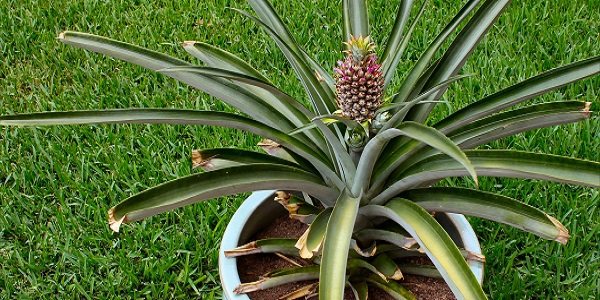

If the root rosette already has root rudiments, it can be immediately planted in light soil from a mixture of peat, perlite and a ready-made substrate for indoor plants.
Flowering stimulation
Pineapple blooms after 3-4 years. If this is not the case, you need to use one of the recommendations:
- Calcium carbide (1 tsp) is dissolved in water (500 ml). The remedy is infused for a day. Then the liquid must be drained, leaving an impurity and sediment. In the middle of the outlet, you need to pour 50 ml every day for a week. After 1–1.5 months, the pineapple can bloom.
- Cover the plant with a plastic bag. A few steaming coals should be placed near the pot. The plant will bloom in 2–2.5 months. But this procedure should be performed 2-3 times with a break per week. After the end of the smoking of the coals, they are removed and the bag is removed from the pineapple.
- Place the pot in a large bag. Tomatoes or apples (3-4 pcs.) Are also put there. When the fruits go bad, they are replaced with new ones.
Such rules are great at home, since tropical conditions are much different from home. These methods provide excellent flowering. Such a plant will also be an excellent home decoration.
Features of the growth of homemade pineapple
After planting, the top of the pineapple takes 1 to 2 months to root. The first sign that the plant has taken root is the regrowth of young leaves. They appear in the center of the rosette and are light green in color. At the same time, the lower leaves gradually move away from the trunk, turn brown and die off. They need to be trimmed periodically. When transplanting, the plant is buried a few centimeters deeper, and the trunk does not look bald.
The first flowering, under favorable conditions, starts in the second or third year of the pineapple's life, approximately in May. The height of the plant by this time reaches 25 cm. The bud is formed at the top and gradually moves away from it on the growing stalk. After its appearance, flowering begins within 2 months and lasts approximately 2 weeks. Blue flowers open in turn, each for just a day.
After the last flower dries up, a fruit is formed. It ripens from 4 to 5 months.
From the beginning of October, the pineapple begins a dormant period. Its growth stops. Hibernation continues until about March.
If the pineapple is already sufficiently developed but not bearing fruit, the flowering can be stimulated with calcium carbide. To do this, a piece the size of an egg is poured into 2 liters of water and kept in a closed container for a day. During this time, a precipitate forms at the bottom. You need to carefully drain the upper liquid layer and use it as fertilizer. To stimulate flowering, the solution is poured into an outlet daily for a week for 50 g.
Fruit
The crop appears 6-7 months after flowering. Pineapples will weigh 0.3–1.5 kg. A sweetish smell testifies to the ripeness of the fruit. At this time, you should not use mineral fertilizers, feeding can only be done with organic substances.
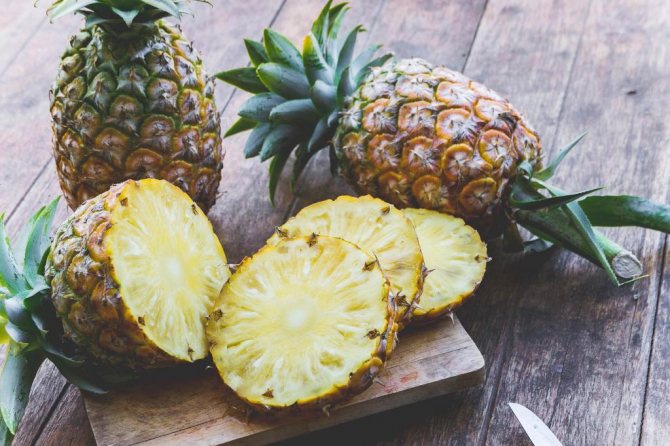

When fruiting is complete, new shoots appear on the pineapple for 2-3 years. Then the plant dies. The babies are usually seated again in the same way as the top. After that, you need to follow the same care rules that are indicated above.
Pineapple can grow well at home. If you follow the above rules, then after a few years there will be delicious and fragrant fruits grown on your own. If you want, you can grow multiple trees for a richer harvest.
General information about the plant
Pineapple is an annual plant in the bromeliad family. The fruits are formed on herbaceous shrubs, about a meter high. The oblong leaves form a rosette, from which one flower and a fruit are later formed. After it ripens, the mother part of the plant dies off, and new rosettes form new inflorescences.
This feature of pineapple allows you to grow it at home, while not worrying about the quality of the product. At home, the fruits are formed in smaller sizes, but this is not reflected in the taste.
Pineapple diseases and their treatment
Diseases and problems of pineapple are more convenient to consider in summary form.
Table: the main diseases of pineapples, their causes and treatment
| Problem / Illness | Cause | Treatment |
| Infected with spider mites (if the air is dry), mealybugs, scale insects (brown plaques appear on the leaves and stems), aphids, phylloxera | Treatment with soapy water, washing with warm water and spraying with Actellic (1-2 ml per liter of water). | |
| Leaves dry | The room is hot and lacks moisture | Watering and spraying on a regular basis. Transfer the plant to a cool place. |
| Pale color of leaves | Lack of light | Change the position of the pot: put it closer to a window or other light source |
| The tops of the leaves turn brown and dry out | Lack of moisture | Spraying the plant and increasing the humidity in the room |
| Grows slowly and does not bloom | Lack of nutrition | Plant feeding |
| The lower leaves dry out, sag and curl | Sign of disastrous drafts | Protecting the plant pot from drafts or changing its position |
| The socket is loose and falls apart | Lack of illumination | Change the position of the pot: put it closer to a window or other light source |
The benefits and harms of pineapple. Who shouldn't eat pineapple?
In addition to many useful properties, there are also contraindications to the use of pineapple.
With increased acidity of the stomach, gastritis and peptic ulcer, it is worth refusing to use pineapple or fresh pineapple juice. Due to the acids present in it, irritation of the mucous membrane of the stomach and intestines can occur.
Do not forget about the condition of the teeth after pineapple. To keep your tooth enamel intact, after eating pineapple, rinse your mouth with warm water or baking soda solution to protect against acid attack on dentin. Do not brush your teeth after eating pineapple, as this can damage the weakened enamel. Cleaning can be done no earlier than an hour later.
If you feel any instability in the work of your stomach, then it is better not to drink pineapple juice on an empty stomach, drink fresh pineapple with water.
It is advisable for children under 6 years old to dilute pineapple juice with water, due to the increased concentration of acids. During pregnancy, use pineapple with extreme caution! Unripe or rotten fruits, according to some sources, have an abortive effect. Do not consume pineapple juice made from spoiled fruits.
Pineapple is a powerful allergen. Pineapples should be used with caution for allergy sufferers sensitive to tropical fruits.
Pineapple is not endowed with any super unusual harmful properties. Take due care in the presence of individual contraindications, do not overeat and then the pineapple will only benefit you.
Growing pineapple from the apical rosette of leaves - step by step instructions
Reproduction of pineapple from the top is not too laborious process and is quite possible at home. The process consists of several sequential steps - from selection of a variety to harvesting. Each involves the creation of certain conditions, requires the application of effort, etc., but is not too complicated. By following gardeners' recommendations for growing a tropical plant from the top of the house, you will easily succeed in this exciting business.
How to choose a fruit
To start growing fruit, any time of the year is suitable, except, perhaps, winter. During this period, the fruits can be frozen and will not germinate, but simply disappear. The best period is late spring - early autumn. Make the choice of pineapple, taking into account the following recommendations:
- The fruit should be ripe, with elastic leaves of a rich green color, a brown, yellow tint indicates a poor-quality product.
- The peel of the fruit should be yellow-golden in color, if a greenish tint is present, it means that it is not ripe.
- Move the leaf of the top of the plant if it quickly returns to its original place - the fruit is overripe, this is not suitable for growing from the top at home.
- Inspect the point of growth of the outlet; it will be difficult to get a new shoot from a rotten one.
- Ignore fruits with brown leaf spots, which are signs of insect infestation.
- Choose 2-3 fruits, as there is a risk that you may not be able to grow pineapple the first time with one fruit.
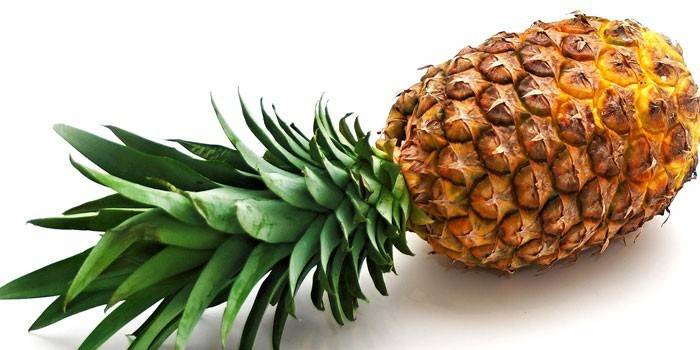

Apical preparation for planting
The process of preparing the apex (rosettes, crowns) is lengthy, but not complicated.Remove some of the lower leaves to expose the trunk a bit. Take it at the base and turn out the stem with leaves. If the fruit is not ripe, it will be difficult. Then take a sharp knife, cut off the upper part without touching the pulp, its presence will provoke rotting.
The angle of inclination of the cutting tool is 450, but in no case horizontally, try not to damage the buds, foliage and the stem itself. If the pulp gets in, it needs to be cut out. The cut of the top should be rubbed with activated charcoal and left in the fresh air to dry for several days. Make sure that the process does not drag on for a week, as a rule, three days are enough.
- How to plant a mango and grow it from a stone at home - choosing a soil, watering and feeding
- Cyclamen - home care, choice of soil and pot, rules for growing, reproduction and transplantation
- How to water a cactus at home in winter, summer and during flowering - basic rules of care
Germination of roots
By and large, the top that has been dried at home can already be planted in the ground, but often, when rooting occurs in the ground, the process of decay begins. It is better to germinate the roots in water and plant the already prepared cutting. To do this, place the sprouted outlet in a glass of water, immersing it 4 cm, trying not to wet the foliage. The liquid is suitable boiled, the need for replacement - every 2 days. A place suitable for rooting is a dry room darkened from direct sunlight. After about 14 days, roots will appear, and the top can be planted in the ground.
Reproduction of Pineapple:
Pineapple propagates by separating offspring, which are formed after fruiting next to the main rosette of leaves or from the upper rosette, which is cut off with a part of the fruit.
In order to reproduce, the offspring must reach a size of 15-20 m, after which it is separated from the mother plant and planted in the soil.
You can read about the reproduction of Pineapple from the fruit outlet in the article How to grow pineapple (Ananas) from the top of the house.
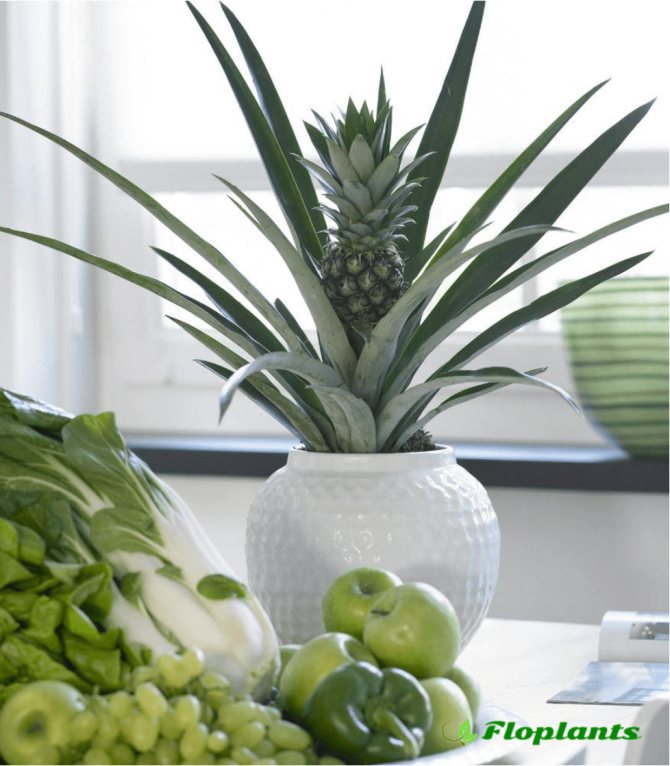

Real pineapple
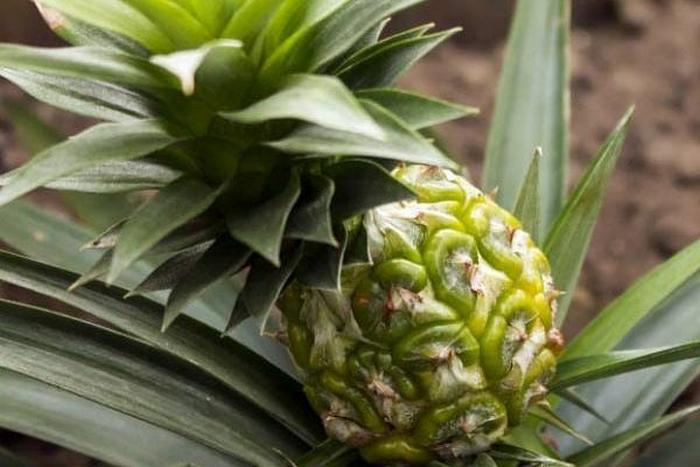

Pineapple (crested) Ananas comosus belongs to the Bromeliaceae family, a perennial plant that takes root in soil and is incredibly resistant to drought and heat. Real pineapple comes from tropical Brazil. Christopher Columbus was the first to bring the plant to our world. Pineapple cultivation moved to Hawaii, today it is grown in large quantities. The fruits ripen all year round; they are available in stores at any time of the year.
The leaves are oblong and narrow, forming a rosette, with spiny teeth at the ends. Between 10 and 20 months of cultivation, a fleshy shoot develops from the center of the rosette, an inflorescence with numerous purple flowers forms at the top. The fruit is formed from about 100 small flowers.
Homemade pineapple care. Light and temperature.
Pineapple is a tropical plant and cold, much less frost will kill it. If you live in a temperate climate, your indoor pineapple can be placed on the balcony for the summer or taken out into the garden, in a moderately lit place. Exposure to fresh air stimulates its growth. Pineapple should be located in a well-lit place for at least 6 hours a day, regardless of the season.
During colder months, keep the plant indoors, draft-free and away from heating appliances. In winter, place the pineapple tree on the south side for maximum sunshine. The optimum temperature for pineapple is 22-26 degrees Celsius, if you feel comfortable, then indoor pineapple feels good too.
Pineapple selection is the key to success
The exotic fruit is native to South America and grows well in tropical climates around the world. This perennial herb belongs to the genus Bromyelids.
Ripe fruits reach a weight of 2-16 kg. They are sold together with tufts of green dense leaves.It is from this top that we will grow a new fruit. This is possible, since the growth point remains at the top.
To be sure of the success of your work, you need to choose the right pineapple for seedlings.
What kind of fruit you need to buy:
- The rind should be whole and shiny - brown-golden. Scratched or cut specimens should be discarded.
- The fruit for planting should be ripe, but not overripe. The juicier, riper and tastier the seed, the better the result. You should not choose half-green cheap specimens for breeding for stock in a supermarket.
- Landing is carried out with the upper part - the crown. The main attention should be paid to its characteristics. Leaves should be whole, bright, not torn or damaged. If you pull them down, they should resiliently return to their original position.
- Pineapple should look lively and vigorous, and not overwhelmed by the scum. Fruits that appear in late summer and autumn are best suited for this. At this time, it is best to start breeding work.
Choose winter specimens with caution - they may be frostbitten. For this reason, it is best not to pick fruit outside.
Summing up, let's say - the less the fruit was lying around in the back rooms, crumpled and shifted from counter to counter, the better germination it will show.
How to choose a ripe pineapple - video:
Transfer
So, we learned how to plant a pineapple. The photos in the article can also help in this process. Now you need to wait until the socket is completely rooted. In the next step, the plant is transplanted into another larger pot in the same way as described above. After that, you need to cover the plant with a special cap, which can be removed after 2-3 weeks.
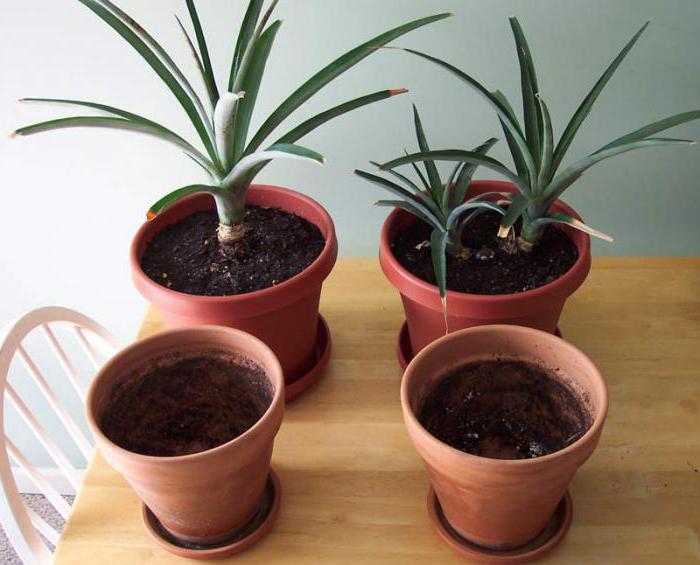

After that, the pineapple should be regularly watered with warm or even hot water. At the same time, you need to add liquid a little less often, as the soil dries out. During the development of new leaves, moisture will begin to accumulate in their axils, thanks to which new roots will form.
Speaking about how to plant pineapple correctly, it should be borne in mind that this plant loves the sun and tolerates drought well. In the summertime, a rooted flower is recommended to be displayed on a well-lit windowsill or on a balcony. However, it is better to clean it indoors before it rains. Also, if you wish, you can transplant the pineapple into the greenhouse for the summer. Such an environment will be optimal for him.
Fruiting and harvesting
By the end of 6-7 months of flowering, the first fruit will appear, the total weight of which can reach from 300 g to 1.5 kg. Fertilization at this time can only be done with organics, mineral fertilizing is not recommended. Ripening is determined by the sweetish aroma, rich yellow color, when this happens, the plant will allow young shoots to form, and subsequently die. New shoots can be grown at home in the same way as the top, they will take root much faster, starting to bear fruit earlier.
Pests and diseases.
Indoor pineapple will be minimally affected by pests with proper care. However, even in the home, pineapple can attack mealybugs and various mites. These pests can be removed by washing the plant with soapy water and then rinsing it with clean water. It is possible to use insecticides, be sure to follow the instructions of the drug.
Another disease that your pineapple may suffer from is core rot caused by fungal attack. The central leaves of the diseased plant turn black and are easily pulled out of the trunk. In case of fungal infection, pineapple can be preserved by pouring the fungicide into the core of the plant. If the agent destroys the infection, then the plant will release a lateral shoot; the old trunk can be cut off over time.
Reproduction, flowering and fruiting
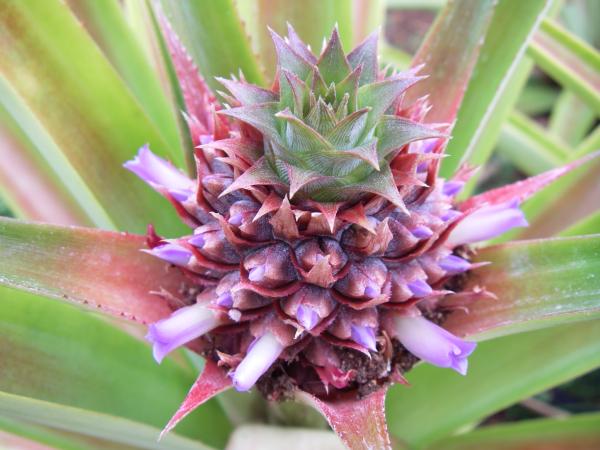

The great interest of flower growers has recently led to the incredible popularity of such an exotic plant as a pineapple in a pot. Can you eat a similar fruit? It all depends on how well it is grown.
This plant blooms from May to July, but there were situations when the pineapple suddenly began to bloom in December. Only those plants that are more than three years old are blooming. They have a compactly located compound fruit, very similar to a lump. The flowering period lasts about two weeks, but the flowers, which attract with their unusual purple color with a blue tint, open only for one day. Moreover, there are usually a lot of them.
As soon as the flowering ends, you need to remove the dried leaves so that the plant goes into the stage of formation and development of the fruit. If flowering did not come, then this means that the care of the plant was incorrect. Do not despair right away, as you can still fix it. For example, stimulate flowering by treating the plant with an aqueous solution of acetylene and ethylene. Someone even uses apples, which release ethylene during storage. It is enough just to put a few fruits in a pineapple pot.
The fruit begins to ripen in about five months. A shortened shoot appears from above, which is called the sultan. The fruit usually ripens within five to six months. This period depends on how it is taken care of, whether all the requirements are met and the peculiarities of the growing season are observed. Immediately after fruiting, the plant dies, but lateral shoots remain, which can be used for reproduction.
Growing problems


The main problem faced by those who grow pineapple at home is the lack of flowering. The plant is completely ready for this process in the third or fourth year of its life. However, the pineapple itself does not always bloom, even with proper care. Especially persistent flower growers stimulate flowering artificially.
An exotic plant, like other flowers, can be affected by diseases and pests. The appearance of the pineapple will help determine the problem:
- Dried leaves indicate that the plant is too hot. It must be sprayed with water as soon as possible and rearranged in a shaded place.
- If the leaves begin to fade and curl, the reason is insufficient illumination. Install additional lighting or move the pineapple pot to a lighter window.
- A rotting trunk indicates chronic overflow. You need to adjust the humidification mode.
Fungal diseases can occur due to improper care and maintenance. In this case, dry or weeping brown spots will appear on the leaves. It is possible to suppress the development of fungal spores with the help of fungicidal preparations. Pineapple pests can be annoyed by:
- mealybug;
- root worm;
- spider mite;
- orchid aphid;
- shield.
It is recommended to deal with them with the help of industrial insecticides, which are used in accordance with the instructions. In the initial stages of infection, you can try spraying the leaves with a solution of laundry soap.
How to grow an avocado from a seed
How to grow pineapple at home? Mistakes and Experiences: Video
How to properly plant pineapple from the top?
Before you can admire your own pineapple on the windowsill, you should learn how to grow pineapple without making mistakes. First you need to find a pineapple suitable for this purpose on sale. It is better to buy pineapple for planting stock in summer or early fall. The fruit should be ripe and exude a delicate aroma, its rind should be golden brown, the leaves should be green and firm. Do not take pineapple if its leaves are dry or frostbitten, gray "dusty" color, have spots (which may indicate damage to them by pests).
How to prune pineapple for planting?
The easiest way to prepare planting material is by literally unscrewing the "tuft" of leaves from the fruit. Algorithm of actions:
- Wear gloves to protect your hands from the thorny leaves.
- Firmly grasp all the leaves with the fingers of one hand closer to the base.
- Hold the fruit firmly with your other hand.
- Slowly but firmly rotate the tip as if you were removing a screw.
It is important not to overdo it. From a ripe fruit, the top should be unscrewed without problems, but if it does not work, then it can be cut out with a sharp, clean knife. Here's how to prune pineapple properly:
- Having departed 4-5 cm from the tuft, make a cut.
- Keeping the knife at 45 °, cut the leaves together with the root of the pulp. Don't damage the core!
- Make sure the flesh is completely peeled off the root, otherwise it will rot during planting.
Useful Tips
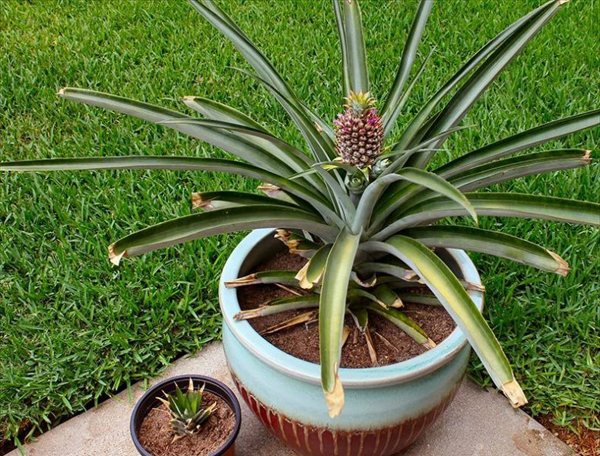

To keep pineapple growing in your home hassle-free, there are some tricks to consider. Those who have already rooted the tip of the tropical fruit recommend the following:
- After the next transplant of a young pineapple into a large container, cover it with a cap for a couple of weeks. Greenhouse conditions will speed up the adaptation of the plant in the new pot.
- Watering the pineapple is recommended rarely, but abundantly. Water, accumulating in the sinuses of the leaf outlet, stimulates the formation of new roots.
- The roots of the plant are located in the surface layer of the soil, so it is better to choose a wide and shallow pot for it.
- If you keep pineapple in the garden during the summer, bring it in the greenhouse during the rain. At the end of summer, it is important not to miss the moment when the temperature starts to drop. Mid-August is a good time to return the plant pot to your home.
- Young shoots that form after flowering should be removed only when they have their own roots.
- Despite the light-loving tropican, direct sunlight can damage it. Avoid keeping your pineapple pot in the summer months on a southern windowsill without shading.
- You should not try to root the crown of a fruit purchased in winter. During this time of the year, fruits are often stored at low temperatures and the tuft may be frozen over.
- While the pineapple rosette is taking root, it must be protected from direct sunlight, drafts, and sudden temperature changes.
- It is advisable to dry the cut on the "tuft" in an upright position, then the wound will dry out faster and all the nutrients necessary for the formation of roots will be concentrated in the desired zone.
- It is best to stimulate flowering in the summer. In this case, there will be a better chance of success.
Among other exotic fruits, pineapple is the most popular. Why not try to root the "tuft" remaining as waste. Taking care of the plant, you will certainly enjoy it, and if flowering occurs, this is a sure sign that you have found a common language with the plant, and it will reward you with a delicious and fragrant fruit.
Beneficial features
This fruit is prized for its delicious, juicy and highly aromatic fruits that are eaten both raw and cooked. We can buy it canned, in jams, compotes, juices and many other types. A very important feature is that pineapple contains the enzyme bromelain, which facilitates digestion and helps to lose weight. Fresh fruits contain the most vitamins. Canned fruits lose some of their beneficial properties during processing.


- Pineapple is a great fruit for people who are on a diet because it contains a lot of fiber. Fiber speeds up digestion and removes toxic metabolic products.
- Bromelain, found in pineapples, promotes weight loss, and also acts as an anti-inflammatory, anti-edema and analgesic to prevent blood clots.
- The fruit is used supportively in the treatment of cardiovascular diseases, arthritis and other inflammatory diseases.
- The fruits contain disinfectants, and also have the ability to remove dead tissue without damaging new ones, therefore they are used to heal wounds, treat burns, bites, bruises and edema.
- As an adjuvant, they can be used in the treatment of allergies and respiratory diseases, as well as for digestive problems.
- Pineapples are also used in cosmetics. Vitamin C contained in the fruit removes age spots and brightens the skin.
- This fruit strengthens blood vessels. The organic acids and bromelain contained in the fruit gently exfoliate dead skin cells, while minerals nourish it. Pineapples are especially recommended for people with skin pigmentation and acne.
- Pineapple is often used as an aphrodisiac.
Growing
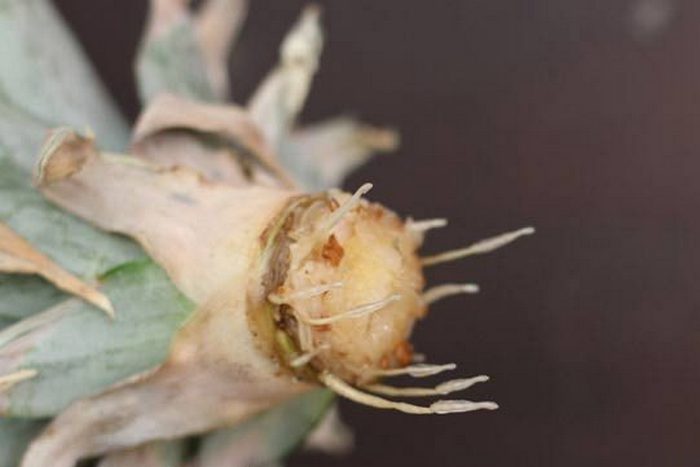

Pineapple is not a very demanding plant. Watering is required in moderation, the earth needs to dry out between waterings. In the summer, every 2 weeks, feed with a liquid multicomponent fertilizer, poured into the soil and into a leaf outlet, the plant also receives nutrients through the leaves. Do not overdo it with the amount of fertilizer! As a rule, we use half the dose recommended by the manufacturer.
In summer, the plant loves warmth 20-30 ° C - the optimal temperature. Growth stops below 20 ° C. In winter, the temperature should not drop below 15 ° C. Cold air, frost, damages and the plant dies.
Description
Pineapple is a perennial plant that forms rather dense leaves during the growing season, which are subsequently transformed into a dense rosette. A very thick and strong stem grows out of it, at the top of which a peduncle appears. Its length can reach 50 cm. The plant blooms with spike-shaped flowers.
For the first time, pineapple appeared in Brazil, so this country is considered its legal homeland. There are 8 varieties of this unusual plant in total.
Today pineapples are sold in almost all chain stores. At the same time, the price of an overseas fruit is low. Eating delicious pulp, everyone at least once thought about how to plant a pineapple. To some, this idea seems stupid, but it can actually be implemented. The main thing is to properly prepare everything you need.
How to grow pineapple at home
It's hard to find someone who doesn't like pineapples. But few people know that this extraordinary fruit can be grown by yourself. Let's figure out how to do this.
From seed
Sowing with seeds is probably the most difficult of all cultivation methods. Those fruits that are sold in stores are usually harvested at the stage of technical ripeness and are completely unsuitable for this planting option. You need to purchase ripe pineapple seeds. They are dark brown in color and 3-4 mm in size.
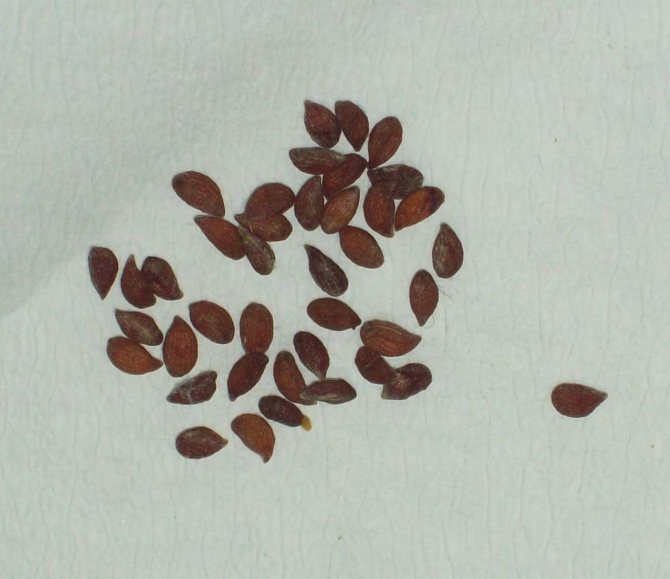

Only mature sprouted seeds are suitable for planting pineapple.
Prepare the material for planting in advance.
- Place the seeds in a humid environment for about a day. It can be a sponge or a damp cloth.
- For planting, take peat and sand in equal amounts.
- Bury the swollen seeds in the soil mixture no more than 2 cm.
- Pour warm water over everything and create a greenhouse effect. Use film, plastic bag, or glass. Now they sell ready-made mini-greenhouses - they are perfect for sprouting pineapple seeds.


A ready-made greenhouse for growing pineapple seedlings can be purchased at a garden store
Place the container in a warm place: the most favorable temperature is from 22 ° C to 30 ° C. The higher it is, the faster the seeds will germinate. You can put the greenhouse on the battery by placing a plank under it. At average room temperature, the first shoots will appear in about a month.
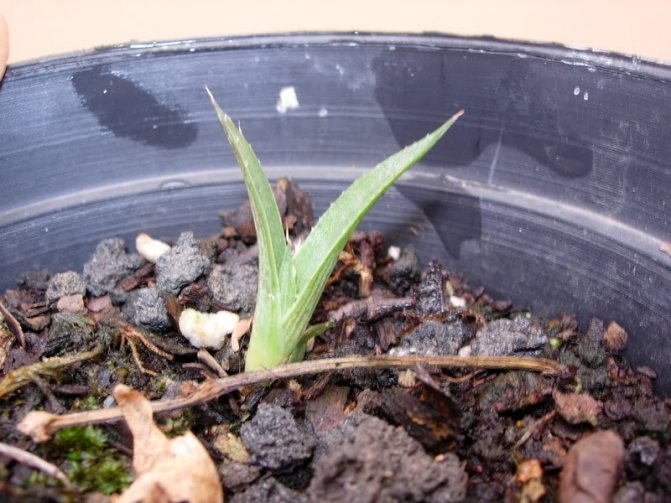

A pineapple sprout at the three-leaf stage can be transplanted from the parent plant into a separate pot
Monitor soil moisture and feed seedlings every 3 weeks. The grown seedlings must be cut into separate pots so that each young shoot turns into an independent fruiting plant. With the growth of seedlings, it is necessary to increase the volume of the pot so that the development of the root system in young shoots does not slow down.
Interestingly, all cultivated pineapples do not contain seeds, but if they are crossed with wild forms, they regain the ability to form them.
From the top
In order to grow pineapple from the top, you need to choose the right fruit. Winter fruits are not suitable for this, because during transportation, the rosette of the plant often freezes. A fresh fruit with a dense, healthy top will do. The leaves should be green, not shriveled or spoiled. Departing from the leaves 2-3 cm, cut off the top.
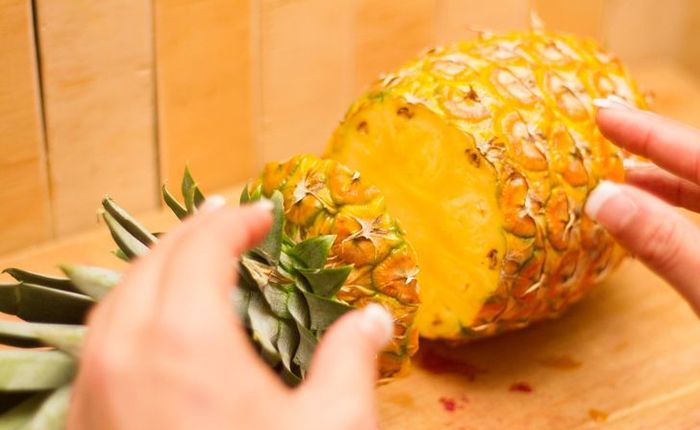

It is necessary to cut off the top for planting, departing from the leaves 2-3 cm
Here's a step-by-step guide on how to prepare a pineapple rosette for planting:
- If the pineapple is ripe, try unscrewing the outlet gently. All juicy pulp must be peeled off, as well as the lower leaves must be removed.
- The cut is treated against damage with a manganese solution. You can dry the top for one or two days to prevent decay.
- To accelerate the formation and development of roots, treat the cutting with growth stimulants (Epin, Kornevin). To do this, lower the top with a cut into the prepared solution for 12-18 hours.
- For further germination, place the tuft in water, securing it to the surface. If the container with water is rather narrow, then the plant will hold on by itself, due to the leaf outlet. If the seedling falls through, secure it with toothpicks or a cardboard circle with a hole in the middle.
- After waiting for the roots to appear, the top is transplanted into a specially prepared soil.
Video: how to sprout the top of a pineapple at home
Germination
After two weeks of exposure, the workpiece should be placed in water. For these purposes, simple tap water is suitable, which is simply defended for 2-3 days.
The roots are obtained in a small glass container - a glass, a cup, a small jar. Only the lower part is dipped into the water, the leaves must remain in the air. From the bottom of the workpiece to the bottom, leave 3-4 cm so that there is room for the roots to grow.
The water is changed every 2-3 days. It is necessary to ensure that the heavy workpiece does not fill up the jar and the roots do not end up in the air. Germination usually occurs within a week. When the length of the roots reaches 2 cm, the plant is transferred to the soil.
What is the use of decorative pineapple
When considering the question of what is the use of decorative pineapple, it is worthwhile to understand that a plant in a pot has aesthetic beauty and cheers up well. Living room vegetation also helps purify the air, and the grown fruits can be used to make healthy recipes.
Now reading: Why lemon water is useful and how to drink it correctly
Most often, ornamental pineapples are grown to obtain a beautiful exotic plant in their home or greenhouse. The process of caring for the culture does not cause any particular difficulties, and the result is noticeable after a few years, provided that all recommendations are followed.
How to grow a pomegranate tree from a cutting.
The use of cuttings as planting material is the most common method of agricultural propagation of pomegranate trees. In this way, the genetic material of the plant is completely preserved, and with it the quality of the fruits and resistance to diseases.
For a cutting, in early spring, you need to choose the middle of a two-year branch with three to four buds, about 15 cm long. It must be placed in water for two days, or treated with a solution that stimulates root growth.The cutting should then be placed in rooting soil similar to the seed germination substrate. After 3-4 weeks, when rooting in warm home conditions, the cutting should acquire a primary root system, and the buds should begin to develop into new branches.
Once adopted, the pomegranate stalk should be carefully transplanted into a larger pot with sandy soil suitable for an adult plant. When the tree gets stronger and reaches a height of at least 50 cm, it can be planted in open ground, or left at home, but transplanted into a large pot for permanent residence.
In the future, when the maximum size of the pot is reached, the pomegranate can not be transplanted; it will be enough to replace the topsoil twice a year and carry out top dressing during the period of fruiting and active growth.


